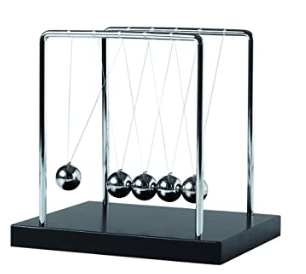Starlight and Stardust
The Painting's Subject


The painting shows an imaginary conversation about Light between Olé Romer and his wife, Anne Marie Bartholin. Anne Marie is holding a glittering spark of light in a glass vacuum bottle.
Olé Romer A Court Scientist
Olé was the court scientist for Louis XIV in the 1670s. He was studying Jupiter’s moons. Thereupon he noticed that when Jupiter’s elliptical orbit made it more distant from Earth, it took Light longer from Jupiter’s moons to Earth. Until this time, Light was believed instantaneous. However, his only possible conclusion was that light had a speed. With this in mind, Olé calculated the speed of light to within 20% of what is accepted today. However, Olé believed “space” was a vacuum. He was in error.
Space Is Not A Vacuum
The proposition that light has a fixed rate of speed in a vacuum has hindered the understanding of light. It is a common misconception that outer “space” is a vacuum. In fact, there are particles in “space,” including dust, atoms, and molecules. Nevertheless, interplanetary “space” particles have a low density, approximately five particles per cubic centimeter around Earth. However, the density decreases with the distance from the Sun. “In certain regions of outer “space,” the temperature is about 3 K, and there are approximately 5 × 106 molecules per cubic meter,” 5atoms/cm3. (From Univers Today, Space and Astronomy News.)
Light Has Different Speeds
The light’s speed is transmitted depending on the material it contacts and passes through. In addition, even temperature affects light’s transmission rate. For example:
-Light’s passage through air at 0 °C and 1 atm pressure is about 299704644.53915 metres per second.
– It passes through water at 20°C: about 224900568.64216053 meters per second
– Through fused silica glass at room temperature, its speed is 205618969.82167354 metres per second.
– Its speed through pyrex glass at room temperature: 203940447.6190476 metres per second
– Its passage through acrylic glass at room temperature: between 200933282.84182307 and 201202991.94630873 metres per second.
Light changes speed because of the difference in “resistance” or friction that it encounters.
It passes like a chain reaction of energy through these materials.
So “space” is not empty, and Light take may take over 4.2 years from the closest star to reach Earth and 13.2 billion light-years from the farthest star. These inter-stellar and inter-galactic regions have less density than areas within our solar system, but light would still encounter significant material in its passage. In summary, the rate of lights transmission (its speed) correlates to the material it passes through.
Matter Can deflect light.
Passing through different densities of matter cause light to change direction, be deflected, or be reflected.
Light’s speed varies, depending on the material it contacts and passes through. Therefore, the velocity we use for light of 186,282 miles per second(299792458 km per second) is only valid for the density in a specific part of the solar system.
There is also a premise is that light travels or moves. Therefore, it instantly fills a void.
However, contacting a surface of a molecule makes light visible. However, the molecule can reflect or emit light. Thus, light can go through materials just as energy passes through the steel balls in Newton’s Cradle.
However, unlike Newton’s Cradle steel balls that transmit power in a straight line, different materials can deflect light’s path. Thus, pool shots would be a more realistic representation of light’s passage and its changes in direction.
Comparing Light With Sound
Light and sound both excite or cause molecules to vibrate as they pass from molecule to molecule. It cannot pass through a vacuum. Light instantaneously fills a vacuum and excites the molecule it contacts. Depending on the molecule, light is either reflected or transmitted through the molecule. The molecule can emit or absorb light. Sound passes from one molecule to another. However, the sound never moves. Light passes similarly. However, a vacuum does not block light. Light’s energy is stored when matter does not emit the exact value of light as it receives.
Newton's Cradle

Summary and Conclusions:
-Light is instantaneous and has infinite speed in a vacuum.
_ matter makes light apparent. It can slow light’s passage, stop it, change its direction, deflect it, or reflect it
.-In Classical wave-optics theory, light behaves like matter when it passes through adjacent pinholes, causing a moiré pattern to appear. This pattern is due not to light acting like matter but by the molecules in the air affecting light’s trajectory.
Similarly, an object’s position will change when a change in density in the material in light’s passage. An example is a drinking straw that goes from air to water in a glass, and the straw seems bent. The same effect with a less sudden shift happens to light from distant stars that pass close to the Sun. This movement is not because of the Sun’s gravity affecting light rays, as Einstein believed. Instead, the star’s apparent position changes because of different densities in space and the atmosphere near the Sun.
Distances in the outer solar system between stars and intergalactic space are significantly greater than current estimates.
Within the Milky Way and far distant galaxies, parallax and cepheid variable stars are used to calculate distances. These methods have difficulties. Earth’s orbit is not an ellipse or circular, and that the solar system is not stationary. However, planets orbit around the Sun in a spiral when seen from outside the solar system (shown at right), plus the Sun travels about 2,261,600,000 miles* in the six months between observations. In addition, the stars in the Milky Way move at different speeds. Stars at the ends of the galaxy’s arms move faster than the stars near the galaxy’s center. Also, the Milky Way galaxy moves about 5,720,000,000 miles* through space in those six months. These movements make calculating distances difficult.